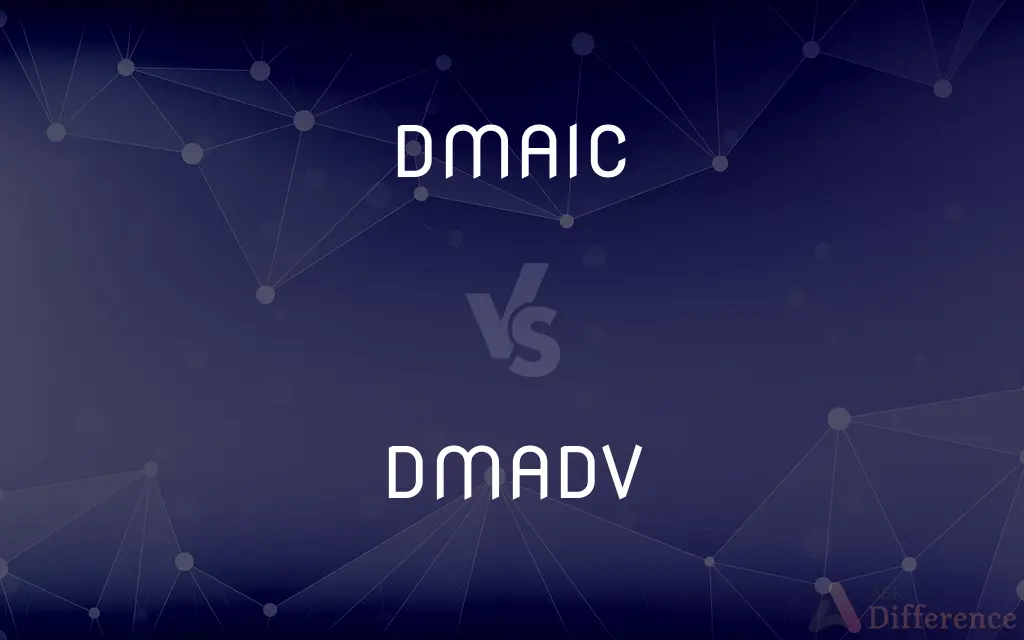DMAIC vs. DMADV — What's the Difference?
By Tayyaba Rehman — Published on December 27, 2023
DMAIC (Define, Measure, Analyze, Improve, Control) is a systematic approach for improving existing processes, while DMADV (Define, Measure, Analyze, Design, Verify) focuses on creating new processes or products.

Difference Between DMAIC and DMADV
Table of Contents
ADVERTISEMENT
Key Differences
Both DMAIC and DMADV are methodologies used within Six Sigma, a set of techniques aimed at improving processes and ensuring quality. They share the initial three phases (Define, Measure, Analyze) but diverge in their latter stages.
DMAIC, standing for Define, Measure, Analyze, Improve, Control, is geared towards refining existing processes. The aim here is to enhance efficiency and reduce defects in an ongoing operation. DMADV, on the other hand, consists of Define, Measure, Analyze, Design, and Verify. This methodology prioritizes designing new processes or products.
The Improve phase of DMAIC is where the process's performance is optimized to meet the desired improvements. This contrasts with DMADV's Design phase, where a new process or product design is created based on the analyzed data.
In DMAIC's Control phase, the improvements made in the previous step are sustained and monitored to ensure long-term success. DMADV's Verify phase ensures the designed process or product meets specified performance levels and requires rigorous testing.
In essence, while both DMAIC and DMADV serve vital roles in Six Sigma, DMAIC refines and perfects existing processes, and DMADV lays the foundation for new, efficient processes or products.
ADVERTISEMENT
Comparison Chart
Purpose
Improves existing processes
Designs new processes/products
Stands for
Define, Measure, Analyze, Improve, Control
Define, Measure, Analyze, Design, Verify
Focus on
Optimization of ongoing operations
Creation based on analyzed data
Final Phase Outcome
Control & sustain improvements
Verify new design meets performance
Best Suited for
Existing processes needing refinement
Initiatives needing new process/product design
Compare with Definitions
DMAIC
A structured methodology for improving existing processes.
Using DMAIC, the company optimized its manufacturing line.
DMADV
Acronym for Define, Measure, Analyze, Design, Verify.
The DMADV framework guided the team through the design phase.
DMAIC
Stands for Define, Measure, Analyze, Improve, Control.
The team went through the DMAIC steps to reduce defects.
DMADV
Focuses on creating efficient designs from analyzed data.
By following DMADV, the engineers crafted a user-friendly interface.
DMAIC
Integral to Six Sigma for refining processes.
With DMAIC, they achieved a higher Six Sigma level.
DMADV
A Six Sigma methodology for designing new processes/products.
The startup utilized DMADV for their product development.
DMAIC
Prioritizes process optimization and defect reduction.
The DMAIC approach helped the firm enhance its delivery speed.
DMADV
Tailored for initiatives needing a new design.
For their new project, they opted for the DMADV methodology.
DMAIC
Ensures sustained improvements through control.
After implementing changes, DMAIC's control phase ensured stability.
DMADV
Ensures the new design meets specified performance levels.
Through DMADV, the system underwent rigorous verification tests.
Common Curiosities
Which methodology is used for improving existing processes?
DMAIC is used for improving existing processes.
Are both DMAIC and DMADV related to Six Sigma?
Yes, both are methodologies used within the Six Sigma framework.
Do DMAIC and DMADV share any phases?
Yes, they share the initial three phases: Define, Measure, and Analyze.
What's the purpose of DMADV?
DMADV is used for designing new processes or products.
In which phase is a new design created in DMADV?
A new design is created in the "Design" phase of DMADV.
Is DMADV more suitable for new projects?
Yes, DMADV is tailored for initiatives needing new process or product design.
Which is older, DMAIC or DMADV?
DMAIC is older and more traditional, but both have been integral parts of Six Sigma.
What do DMAIC and DMADV stand for?
DMAIC stands for Define, Measure, Analyze, Improve, Control, and DMADV stands for Define, Measure, Analyze, Design, Verify.
Are both methodologies iterative?
Yes, both can be iterated to continuously improve processes or designs.
Which methodology emphasizes defect reduction?
DMAIC emphasizes defect reduction and process optimization.
Which phase in DMADV focuses on rigorous testing?
The "Verify" phase in DMADV focuses on rigorous testing.
Can both methodologies be used concurrently in a project?
While not common, organizations can use DMAIC for some aspects and DMADV for others, depending on the project's needs.
How does DMAIC ensure the improvements are maintained?
DMAIC uses the "Control" phase to ensure sustained improvements.
How does DMADV ensure the new design is effective?
DMADV's "Verify" phase ensures the design meets specified performance levels.
Are there specific industries where DMAIC or DMADV is more prevalent?
Both methodologies can be applied across various industries, but the choice depends on the specific needs and objectives of a project.
Share Your Discovery

Previous Comparison
Saltwater Crocodile vs. Nile Crocodile
Next Comparison
4 Star Hotels vs. 5 Star HotelsAuthor Spotlight
Written by
Tayyaba RehmanTayyaba Rehman is a distinguished writer, currently serving as a primary contributor to askdifference.com. As a researcher in semantics and etymology, Tayyaba's passion for the complexity of languages and their distinctions has found a perfect home on the platform. Tayyaba delves into the intricacies of language, distinguishing between commonly confused words and phrases, thereby providing clarity for readers worldwide.














































